Regler KAVAN Smart PRO Opto - Bedienungsanleitung
Einleitung
Intelligente programmierbare elektronische Drehzahlregler für Brushless-Motoren
Herzlichen Glückwunsch zum Kauf des Drehzahlreglers für Brushless-Motoren KAVAN Smart PRO. Die Produktreihe KAVAN Smart PRO stellt fortschrittliche Drehzahlregler für Brushless-Motoren für den ausschließlichen Einsatz in RC-Flugzeugmodellen vor. Mit integrierter Telemetrie und verschiedenen Möglichkeiten der Benutzerkonfiguration bieten die Regler hohe Effizienz, geringes Gewicht und präzise Motorsteuerung. Alle ESCs können schnell über einen Sender, einen Computer oder ein externes Terminal programmiert werden.
Funktionen
- Geringe Größe kombiniert mit hoher Leistung für die Motorsteuerung.
- Über- und Unterspannungsschutz, Überhitzungsschutz, Motorblockierschutz.
- Konfigurierbare Strombegrenzung.
- Schneller und präziser Heli/Governor-Modus mit vielen Einstellmöglichkeiten.
- Optisch isolierter Gaseingang.
- Sicherheitsabschaltung des Motors bei Verlust des Gasimpulses.
- Konfigurierbare Beschleunigung, Timing, elektromagnetische Bremse, Motorumkehr usw.
- Geringe Geräuschentwicklung durch Hochfrequenzschaltung.
- Automatische Telemetrieerkennung: Duplex EX, Hott, MSB, PowerBox P²Bus, S.Bus2. Alternative Firmware mit Telemetrieunterstützung Spektrum SRXL2.
- Telemetrie (abhängig von der RC-Anlage): Spannung, Strom, Leistung, Kapazität, Temperatur, Drehzahl, Energie.
- Minimal- und Maximalwerte der Telemetrie werden aufgezeichnet.
- Konfiguration über den Sender, PC-Software MAV Manager oder externes Terminal (JETIBOX/SMART-BOX).
- Firmware-Updates mit USB-Interface.
- Sprachen: CZ/DE/EN/FR/IT.
| ESC-80 | ESC-120 | ESC-130 | ESC-200 | ESC-220 | |
|---|---|---|---|---|---|
| Abmessungen (mm) | 57×35×28 | 58×53×24 | 58×53×28 | 81×63×35 | 81×63×35 |
| Gewicht inkl. Kabel (g) | 60 | 110 | 110 | 270 | 270 |
| Dauerstrom (A) | 80 | 120 | 130 | 200 | 220 |
| Spitzenstrom (A/2s) | 120 | 160 | 180 | 260 | 280 |
| Versorgungsspannung (V) | 8–51 | 10–59 (max. 64 V) | 10–51 | 12–59 (max. 64 V) | 10–51 |
| LiPo-Zellen | 3–12 | 4–14 | 4–12 | 4–14 | 4–12 |
| LiFe-Zellen | 3–14 | 4–16 | 4–14 | 4–16 | 4–14 |
| Batterie/Motor Kabel (mm²) | 4/2.5 | 4/4 | 4/4 | 6/6 | 6/6 |
| Antispark Schaltung | Nein | Ja | Ja | Ja | Ja |
| Empfohlene Stecker | G4 (75A) XT90 (90A) | G5.5 (150A) | G5.5 (150A) | G8 (170A) | G8 (170A) |
| Temperaturbereich (°C) | (-10)–110 | ||||
| PWM Frequenz (kHz) | 20 | ||||
| Betriebsstrom (mA) | 50 | 60 | |||
| Standby-Strom (mA) | 4 | 10 | |||
| Positionierung der Luftschraube | Mit zusätzlichem Hall-Sensor | ||||
| Telemetrie | Duplex EX, Multiplex MSB, Futaba S.Bus2, Graupner Hott, PowerBox P²Bus, Spektrum SRXL2™ | ||||
| Status-LED | Ja | ||||
| Aktive Bremse
(freewheeling) |
Ja | ||||
| BEC | Nein | ||||
| Optische Isolation | Nur Gaseingang | Komplett | |||
| Maximale Drehzahl (eRPM) | > 300 000 (zweipoliger Motor) | ||||
Installation
Befestigen Sie den Regler mit Klettband oder doppelseitigem Klebeband in Ihrem Modell. Schließen Sie den Motor und den Empfänger gemäß dem unten stehenden Diagramm an. Sie können die Motorkabel in beliebiger Reihenfolge anschließen, da die Drehrichtungsänderung durch Vertauschen eines der beiden Kabel erfolgt (oder auch durch den Parameter „Richtung“ in der Konfiguration). Schalten Sie den Sender ein. Nun können Sie die Hauptflugbatterie anschließen und den Regler mit dem angeschlossenen Empfänger einschalten.
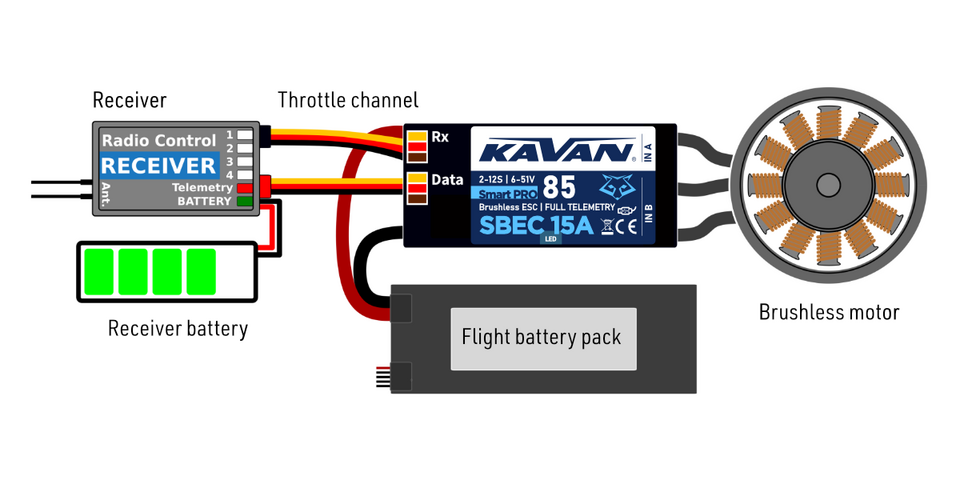
- Verwenden Sie immer ganz neue, hochwertige Stecker und achten Sie darauf, dass die Kabel perfekt verlötet sind. Jede Möglichkeit einer Kontaktunterbrechung bei laufendem Motor bedeutet das Risiko einer Beschädigung der Elektronik.
- Wenn Sie den Regler zum ersten Mal in Betrieb nehmen oder wesentliche Änderungen in den Einstellungen vornehmen, stellen Sie sicher, dass die Luftschraube von der Motorwelle entfernt ist.
- Trennen Sie die Batterien nach dem Flug immer. Auch wenn der Regler mit dem Schalter ausgeschaltet ist, zieht er immer einen kleinen Strom. Dies kann dazu führen, dass die Batterie innerhalb weniger Tage oder Wochen vollständig entladen ist.
Reglermodus
Es ist möglich, zwischen einigen grundlegenden Reglermodi zu wählen:
- Normal (mit Beschleunigung) – beim Beschleunigen wird immer die voreingestellte Beschleunigungskurve verwendet. Dies ist der Standardmodus für den normalen Gebrauch.
- Schnellmodus - the selected acceleration time is only applied when spinning from zero RPM. Then the minimum possible delay is applied (0.2 s for zero to full throttle response).
- Normal mit Reverse - verhält sich ähnlich wie der Normalmodus. Zusätzlich können Sie einen Gasumkehrkanal wählen, der die Motordrehrichtung während des Fluges steuert.
- Heli/Governor – schnelle und präzise Steuerung der konstanten Drehzahl mit vielen einstellbaren Parametern.
Gaseingangssignal
Der Regler erwartet positive Impulse vom Empfänger mit einer maximalen Aktualisierungsrate von bis zu 400 Hz. In der Standardeinstellung, wenn die Endpunkte automatisch eingestellt werden, arbeitet der Regler mit der überwiegenden Mehrheit der RC-Systeme. In diesem Fall wird nach dem Start ein minimaler Gassignalimpuls abgerufen. Die maximale Leistung wird dann dynamisch angepasst, wenn Sie das erste Mal Vollgas geben.
Wenn Sie die genauen Positionen des Senderhebels benötigen, wo der Motor startet und wo das Vollgas ist, können Sie auch die Verwendung von manuell eingegebenen Endpunkten konfigurieren.
Motoreinstellungen
Viele Motorparameter können konfiguriert werden, wie z. B. Beschleunigung, Timing, Übersetzungsverhältnis oder Anzahl der Pole. Das Übersetzungsverhältnis und die Polenzahl sind wichtig für die Telemetrie und die korrekte Anzeige der Motordrehzahl.
Beschleunigung beeinflusst die Reaktion des Motors auf den Gaskanal. Eine Verkürzung der Beschleunigungszeit beschleunigt die Reaktion des Motors und gibt dem Piloten ein Gefühl der sofortigen Kontrolle beim Kunstflug. Allerdings verbraucht der Motor mehr Strom und der Regler erzeugt mehr Wärme. Für die meisten Modelltypen, einschließlich Elektrogleiter, Scales, EDFs usw., empfehlen wir eine Standardbeschleunigung von 1,0 s. Für 3D-Kunstflug können Sie bis auf 0,5 s oder auch weniger heruntergehen (mit Vorsicht). Sie können auch den „Schnellmodus“ des Reglers im Menü „Allgemeine Einstellungen“ einstellen, um die schnellstmögliche Motorreaktion zu erhalten.
Timing hängt vom Motortyp ab und wird in der Regel vom Hersteller empfohlen. Timing beeinflusst auch die Leistung und den Stromverbrauch. Ein höherer Wert für Timing kann die Motorleistung erhöhen, doch muss darauf geachtet werden, dass das System nicht überlastet wird.
- Automatisches Timing: Timing wird kontinuierlich durch einen internen Algorithmus angepasst. Es handelt sich um eine universelle Lösung, die mit den meisten Motortypen kompatibel ist.
- Timing 0-10°: Empfohlen für In-Runner, d.h. Motoren mit internen Magneten.
- Timing 15-20°: Empfohlen für die meisten Outrunner (Außenläufer-Motoren). Bietet eine gute Kombination aus Leistung und Effizienz.
- Timing 25-30°: Motoren mit hohem Drehmoment und vielen Polen erfordern das höchste Timing.
Der Motortyp sollte nur in bestimmten Fällen geändert werden, wenn die Anwendung dies erfordert. Es gibt drei Möglichkeiten:
- "Standard"-Motortyp - empfohlen für die meisten Typen und Anwendungen (Standard).
- "Hohes Drehmoment" - wenn Sie Probleme mit der Motorsynchronisation bei schneller Beschleunigung haben, verwenden Sie diesen Modus. Voraussetzungen sind ein großer Outrunner-Motor mit mehr als 20 Polen, schwere Luftschraube, große Stromspitzen. Wir empfehlen außerdem, das Timing auf mehr als 20° zu erhöhen.
- "Hohe Geschwindigkeit" - verwenden Sie diesen Modus, wenn Ihre Antriebseinheit 250.000 eRPM (Umdrehungen pro Minute, berechnet für einen 2-poligen Motor) überschreitet.
Startleistung beeinflusst die ersten Motordrehzahlen. Wenn Sie mit dem automatischen Modus nicht zufrieden sind, können Sie den Motoranlauf so einstellen, dass der Motor aggressiver (positive Werte) oder so sanft wie möglich (negative Werte) läuft.
Bremseinstellung
Die elektromagnetische Bremse ist eine Standardausrüstung aller Regler, die in elektrischen Gleitermodellen verwendet werden. KAVAN Smart PRO Regler bieten mehrere zusätzliche Parameter zur Feineinstellung der Bremsfunktion. Sie können eine der vorkonfigurierten Einstellungen verwenden oder alle Bremsparameter frei einstellen.
Einstellmöglichkeiten:
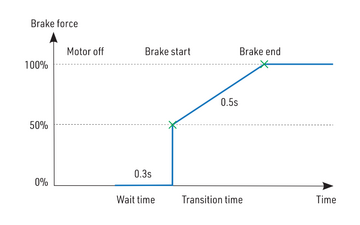
Aus: Die Luftschraube dreht sich frei und wird nicht gebremst.
Weich: Übergang von Null auf volle Bremskraft in 1,0 s.
Mittel: Übergang zur vollen Bremskraft in 0,7 s.
Hart: Übergang von 50% auf 100% Bremskraft in 0,5 s.
Manuell: Alle Bremsparameter können Sie manuell eingeben:
- Anfangskraft (Beginn der Bremse) - die Bremskraft, die ab dem Zeitpunkt der Bremsaktivierung wirkt.
- Endkraft (Ende der Bremse) - die nach Ablauf der Bremsanlaufzeit aufgebrachte Bremskraft (normalerweise die volle Bremskraft, die den Motor ganz stoppt).
- Bremsanlaufzeit - die Zeit zwischen dem Beginn und dem Ende der Bremse. Während dieser Zeit ändert sich die Bremskraft ständig von der Anfangs- zur Endleistung.
- Wartezeit - die Zeit zwischen dem Abschalten des Motors und der Bremsaktivierung. Während dieser Zeit dreht sich der Motor frei ohne Stromversorgung.
Beispiel: Die Motorbremse mit folgenden Parametern: Bremsbeginn = 50%, Bremsende = 100%, Anlauf = 0,5 s, Wartezeit = 0,3 s.
Luftschraubenpositionierung
Die Positionierungsfunktion ermöglicht es, den Motor/die Luftschraube in die exakte Position zu drehen, die für eine sichere Landung erforderlich ist, oder die einfach für den nächsten Flug günstig ist. Mit ein paar externen Komponenten (Hall-Sensor und kleiner Magnet) können Sie diese Funktion nutzen und das Risiko einer Beschädigung der Luftschraube bei der Landung vermeiden. Der Magnet muss ordnungsgemäß am rotierenden Teil (Motor oder Luftschraube) angebracht werden und der Hall-Sensor muss im Rumpf so positioniert werden, dass der Magnet gegenüber dem Hall-Sensor an der Zielposition der Luftschraube liegt. Nachdem Sie die Positionierungsfunktion über das Reglermenü aktiviert haben (Luftschraubenposition =" Hall-Sensor"), stellen Sie auch die PWM-Positionierung so ein, dass sich der Motor langsam, aber gleichmäßig dreht. Sie können auch die Dauer der aktiv gehaltenen Motorposition (Halten der Position) ändern, die aktiviert wird, wenn die richtige Position gefunden ist. Die Funktion des Haltens der Position ist bei einem einziehbaren Antrieb nützlich, da sie verhindert, dass sich die Luftschraube während des Einziehens spontan bewegt.
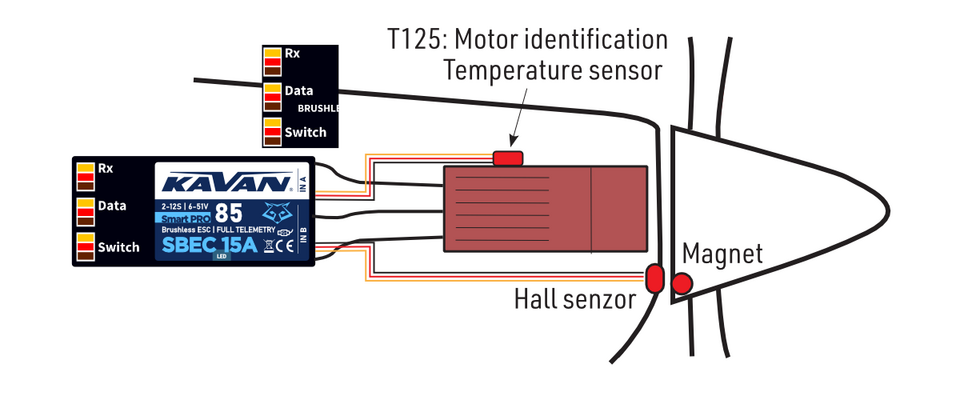
Um die Luftschraubenpositionierung zu aktivieren, schließen Sie den Hall-Sensor an den IN-B Port des Reglers an.
Motoridentifikation
Einige Motorenmarken verfügen über einen integrierten Temperatursensor, der mit Reglern KAVAN SMART PRO kompatibel ist. Dieser Sensor (T125-ID) kann auch als eigenständiger Telemetriesensor mit Duplex/Hott/S.Bus2 Telemetrieunterstützung verwendet werden. Außerdem kann er direkt an den "IN-A" Eingangsport des Reglers angeschlossen werden (siehe Abbildung oben). Ab diesem Zeitpunkt kennt der Regler KAVAN Smart PRO die grundlegenden Motorparameter (Mindestbeschleunigung, empfohlenes Timing, Übersetzungsverhältnis, Anzahl der Pole...) und auch die aktuelle Motortemperatur. Einige Parameter werden automatisch eingestellt (Übersetzungsverhältnis, Anzahl der Pole), andere Einstellungsposten werden übernommen, sobald Sie den Regler auf die Werkseinstellungen zurücksetzen. Der Motoridentifikationssensor wird an den IN-A Port des Reglers angeschlossen.
Synchrones Schalten
"Synchrones Schalten", bzw. "Aktives Bremsen" ist eine Funktion des Drehzahlreglers, die die Wärmeentwicklung des Reglers im Teillastbetrieb reduziert. Dieser Modus ist nützlich für Kunstflugpiloten, die nicht nur schnell beschleunigen, sondern auch schnell abbremsen wollen. Der Motor folgt der Gashebelbewegung sofort in beide Richtungen und der Pilot kann die Kontrolle perfekt übernehmen.
Strombegrenzer
Der Strombegrenzer ist eine der Sicherheitsfunktionen des Reglers. Er stoppt den Motor nicht beim Überstrom, sondern überwacht ständig die momentane Stromaufnahme und passt die Motorleistung auf dieser Grundlage an. Wenn diese Funktion aktiviert ist, bestimmen Sie den maximal zulässigen Strom und der Regler reduziert sofort die Motorleistung, wenn der Stromgrenzwert überschritten wird. Nachdem der Strom auf ein sicheres Niveau zurückkehrt, wird die Motorleistung wiederhergestellt.
Batterieschutz
Der integrierte Batterieschutz basiert auf der Erkennung einer Unterspannung und der Reduzierung der Motorleistung oder der vollständigen Abschaltung. Sie können die Anzahl der Zellen (oder die automatische Erkennung) und den Wert der Mindestspannung pro Zelle frei einstellen. Die unterstützten Batterietypen sind NiXX (1,2 V), LiFe (max. 3,6 V) und LiIo/LiPo (max. 4,2 V).
Antispark-Funktion
Die Regler KAVAN Smart PRO 120/130 und KAVAN Smart PRO 200/220 enthalten eine zusätzliche Schaltung, die optional zur Vermeidung von Funkenbildung beim Anschluss der Antriebsbatterie eingesetzt werden kann. Diese Schaltung wird über ein separates Kabel mit dem Antriebsset verbunden. Verwenden Sie das "Antispark"-Kabel nur zum Vorladen der Reglerkondensatoren. Verwenden Sie dieses Kabel niemals für die Stromversorgung des Motors oder externer elektronischer Komponenten.
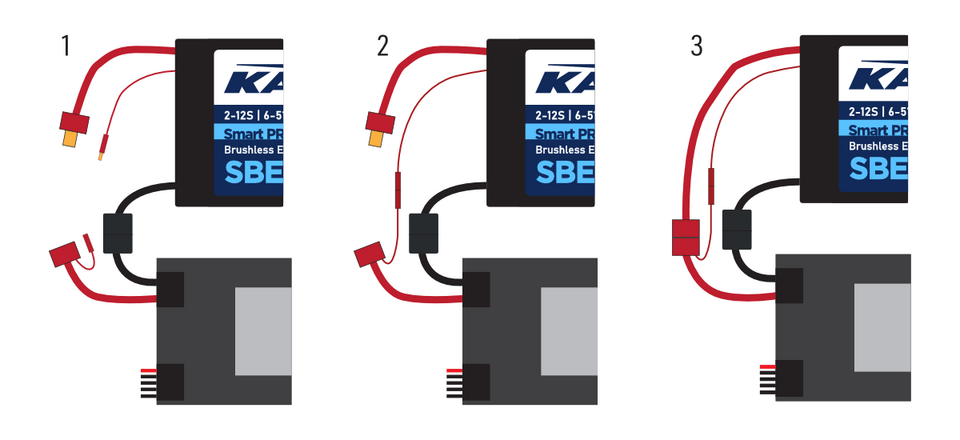
- Schließen Sie den Minuspol (-) der Batterie an.
- Schließen Sie das Antispark-Kabel an den Pluspol (+) der Batterie an.
- Schließen Sie den Pluspol (+) der Batterie an.
Statuscodes
Die Statuscodes werden auf dem Bildschirm (JETIBOX/SMART-BOX) angezeigt, wenn ein Fehlerereignis auftritt. Wenn ein Statuscode aktiviert ist, blinkt die rote LED kontinuierlich.
Verfügbare Statuscodes:
- Niedrige Spannung (UL): Die Batteriespannung ist unter den im Menü Batterieschutz festgelegten Schwellenwert gesunken und der Regler hat entweder die maximale Leistung reduziert oder den Motor vollständig abgeschaltet.
- Hohe Spannung (UH): Wenn Sie eine weiche Batterie oder eine Netzstromversorgung verwenden, kann die Spannung während des Bremsens über den ursprünglichen Wert ansteigen. In diesem Fall wird ein Alarm ausgelöst und alle Bremsfunktionen werden deaktiviert.
- Hochstrom (IH): Der Strom ist höher als der in der Produktspezifikation festgelegte maximale Spitzenstrom (z.B. 120 A für KAVAN SMART PRO 80, 200 A für KAVAN SMART PRO 130).
- Hohe Temperatur (T100, T110, T120): Die Temperatur ist über einen sicheren Wert gestiegen. Der numerische Wert gibt die ermittelte Höchsttemperatur und das aktivierte Sicherheitsprotokoll an.
- Kommutationsfehler (COM): Es wurde ein Synchronisationsfehler bei laufendem Motor festgestellt. Dies tritt in der Regel auf, wenn der Motor plötzlich stoppt, oder bei sehr schneller Beschleunigung bei bestimmten Antriebseinheiten. Dieser Fehler kann auf ein schwerwiegendes Problem in der Motor-Regler Installation hinweisen.
Heli/Governor-Modus

Die Drehzahlregler verfügen über eine Funktion, die schnell und genau die Drehzahl stabilisiert. Der Governor-Modus kann auf viele Arten konfiguriert werden, um Ihren Wünschen zu entsprechen.
Vergewissern Sie sich, dass die Luftschraubenblätter entfernt sind, bevor Sie den Modus für konstante Drehzahl aktivieren. Im Menü Allgemeine Einstellungen wählen Sie den Reglermodus „Heli/Governor“ und folgen Sie den nachstehenden Optionen:
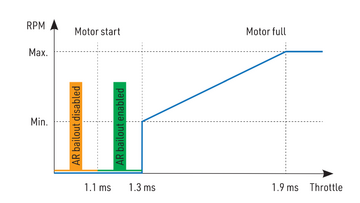
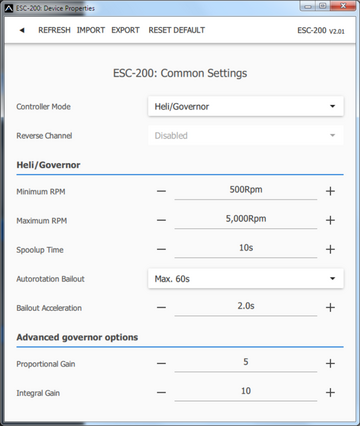
- Stellen Sie die minimale und maximale Drehzahl des Hauptrotors nach Ihren Wünschen ein. Sobald Sie den Gashebel über die Leerlaufposition hinaus bewegen, dreht sich der Motor langsam, bis er die Zieldrehzahl erreicht. Diese wird nach der Position des Gaskanals berechnet, wobei das weggenommene Gas der "Mindestdrehzahl" und Vollgas der "Höchstdrehzahl" entspricht.
- Stellen Sie die Anlaufbeschleunigung so ein, dass der Motor so sanft wie möglich startet. Sie können diese Zeit auf bis zu 60 s einstellen. Die Anlaufbeschleunigung wird verwendet, wenn der Motor bei Null Umdrehungen startet oder wenn die Funktion zum schnellen Verlassen der Autorotation deaktiviert ist.
- Konfigurieren Sie die Autorotationsrettungszeit und die Autorotationsbeschleunigung. Die Autorotationsrettungsfunktion wird verwendet, wenn Sie die Autorotation schnell beenden müssen, um einen Unfall des Modells zu verhindern. In diesem Fall bewegen Sie den Gashebel über die Leerlaufposition hinaus, "Autorotationsbeschleunigung" wird verwendet, um den Motor zu drehen, bis er die gewünschte Drehzahl erreicht. Der Parameter "Autorotationsrettung" bestimmt die Zeit nach dem Abschalten des Motors, in der die Autorotationsrettungsfunktion aktiviert werden kann. Wenn diese Zeit überschritten wird, wird die Standardanlaufzeit verwendet.
- Erweiterte Einstellungen: Governor-Ausschläge - (P)roportional und (I)ntegral. Sie können diese Ausschläge anpassen, um die Reaktion des Reglers auf schnelle Laständerungen während Flugmanövern fein abzustimmen. Bitte nehmen Sie die Änderungen nur in kleinen Schritten vor und überprüfen Sie das resultierende Verhalten bei einem kurzen Testflug.
- Erhöhen Sie den P-Ausschlag, um kleine Drehzahlschwankungen beim Direktflug, z. B. beim Schweben, zu eliminieren. Wenn Sie unerwartete Motor-/Getriebegeräusche hören (die auf schnelle Schwingung hinweisen), reduzieren Sie den P-Ausschlag um 20 %.
- Erhöhen Sie den I-Ausschlag, um eine präzise Drehzahl während der Manöver beizubehalten. Wenn die Motordrehzahl merklich zu schwanken beginnt, reduzieren Sie den I-Ausschlag um 20 %.
- Im Governor-Modus werden immer feste Endpunkte des Gaskanals verwendet (standardmäßig 1,1-1,9 ms) und die aktive Bremsung ist ebenfalls aktiviert.
Die folgende Abbildung zeigt ein Diagramm der Rotordrehzahl in Abhängigkeit von der Gasstellung. In diesem Fall wurden die Standard Endpunkte des Gaskanals (1,1-1,9 ms) verwendet.
Reverse der Drehrichtung
Die Motor-Reverse-Funktion ist verfügbar für RC-Systeme mit bidirektionaler Busunterstützung (EX-Bus, P²Bus, SRXL2, S.Bus2, FPort). Um die Motorrichtung zu steuern, muss ein zusätzlicher busübertragener Kanal am Sender definiert werden. Beide Kabel des Reglers KAVAN SMART PRO (rot und schwarz) müssen korrekt mit dem Empfänger verbunden sein.
Legen Sie zunächst einen zusätzlichen Kanal am Sender an, um die Motorrichtung zu steuern. Dieser Kanal sollte über einen Zweipositionsschalter gesteuert werden.
Futaba/Spektrum:
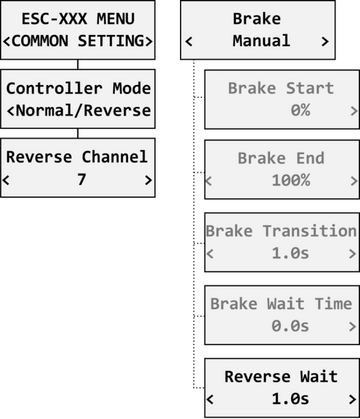
Verwenden Sie einen der AUX-Kanäle und merken Sie sich die Kanalnummer. Es ist nicht notwendig, sich auf die an Ihrem Empfänger verfügbaren Kanäle zu beschränken, da RC-Systeme in der Regel mehr Kanäle auf den Bus senden, als die physische Anzahl der Ausgänge des Empfängers beträgt.
Beispiel: Wenn Sie ein Spektrum NX6 und einen 6-Kanal-Empfänger verwenden, können Sie immer noch auch den Kanal Nr. 7 (AUX2) verwenden, um die Reverse-Funktion über den SRXL2-Bus zu steuern.
JETI:
Legen Sie im Menü Modell - Funktionszuweisung eine neue Modellfunktion an und weisen Sie ihr einen freien Zweipositionsschalter zu. Weisen Sie dann im Menü Modell - Servozuweisung diese Funktion einem der Empfängerkanäle (1-16) zu. Auch hier können Sie wieder Kanäle verwenden, die nicht direkt an den Empfängerausgängen zur Verfügung stehen (z.B. 13-16), da diese ohne Einschränkung über das EX-Bus-Protokoll übertragen werden.
PowerBox:
Im Menü Funktion erstellen Sie eine neue Funktion für das Modell, indem Sie die Taste "+" drücken, und weisen Sie ihr einen Zweipositionsschalter zu. Wählen Sie einen der verfügbaren Ausgangskanäle (1-16). Die Stellung des Schalters wird über den P²Bus an den Drehzahlregler übertragen.
Wenn Sie die Motor-Reverse-Funktion im Regler aktivieren möchten, stellen Sie den "Reglermodus" auf "Normal/Reverse" und stellen Sie den Reverse-Kanal wie im vorherigen Schritt ein. Sie können auch eine Feinabstimmung der Bremseinstellungen und der Wartezeit vor dem Reverse vornehmen, wenn Sie den Bremstyp "Manuell" verwenden.
Überprüfen Sie die Funktion: Sobald Sie den Richtungsschalter umschalten, aktiviert der Regler die Bremse und nach einer kurzen Pause beginnt sich der Motor in die entgegengesetzte Richtung zu drehen.
Galvanische Trennung
Die Regler KAVAN SMART PRO 80 und KAVAN SMART PRO 120/130 haben einen optisch getrennten Gaseingang. Die Regler SMART PRO 200/220 verfügen außerdem über eine galvanische Trennung für alle Signalleiter.
KAVAN Smart PRO 80, 120/130
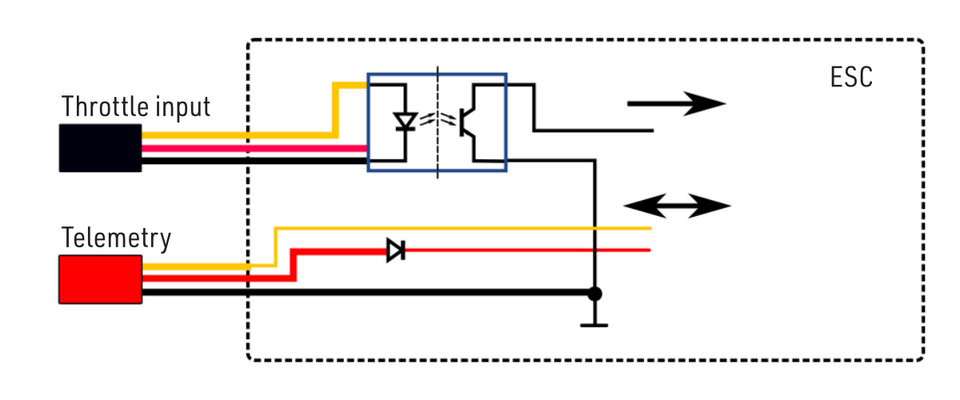
KAVAN Smart PRO 200/220
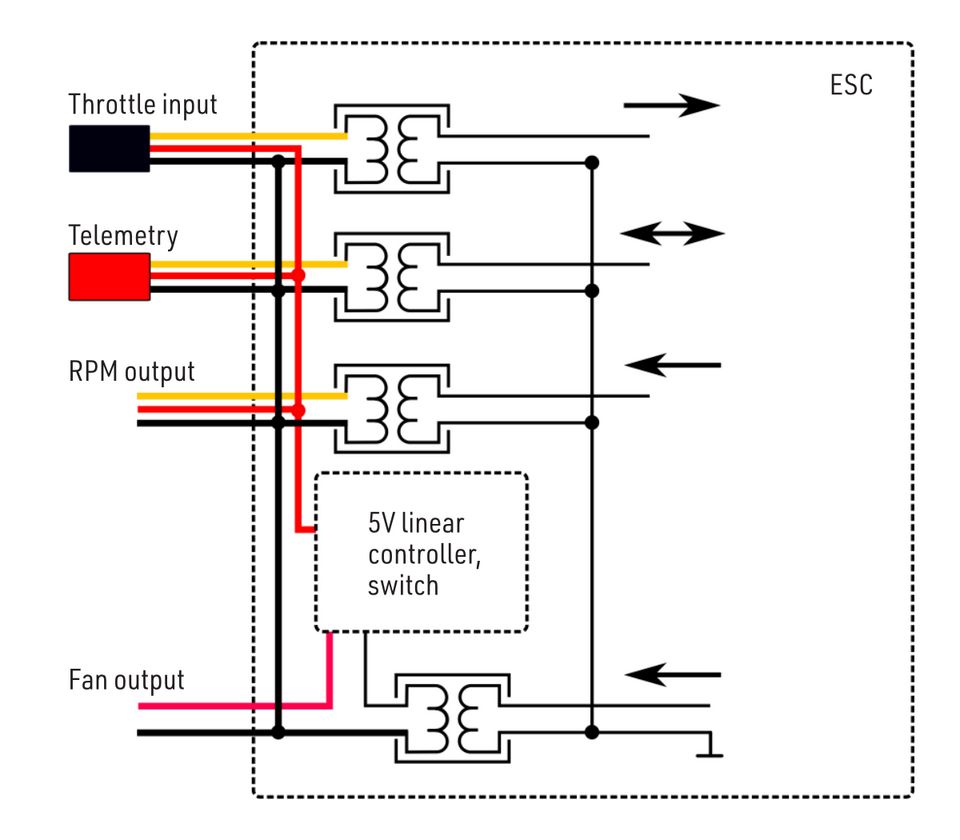
Lüftersteuerung
KAVAN SMART PRO 200/220 verfügt über einen gesteuerten Ausgang für einen externen Lüfter (5V, bis zu 300mA). Er wird aktiviert, wenn die Temperatur des Reglers 55°C erreicht.
Verwenden Sie nur einen geeigneten Lüfter, der als optionales Zubehör des Reglers verkauft wird. Befestigen Sie den Lüfter mit den mitgelieferten Schrauben am Kühlkörper. Schließen Sie den Lüfter an den mit „FAN“ gekennzeichneten Ausgang des Reglers nach der Abbildung links an. Der Lüfter wird von der Empfängerbatterie mit einer stabilisierten Spannung von 5 V versorgt.
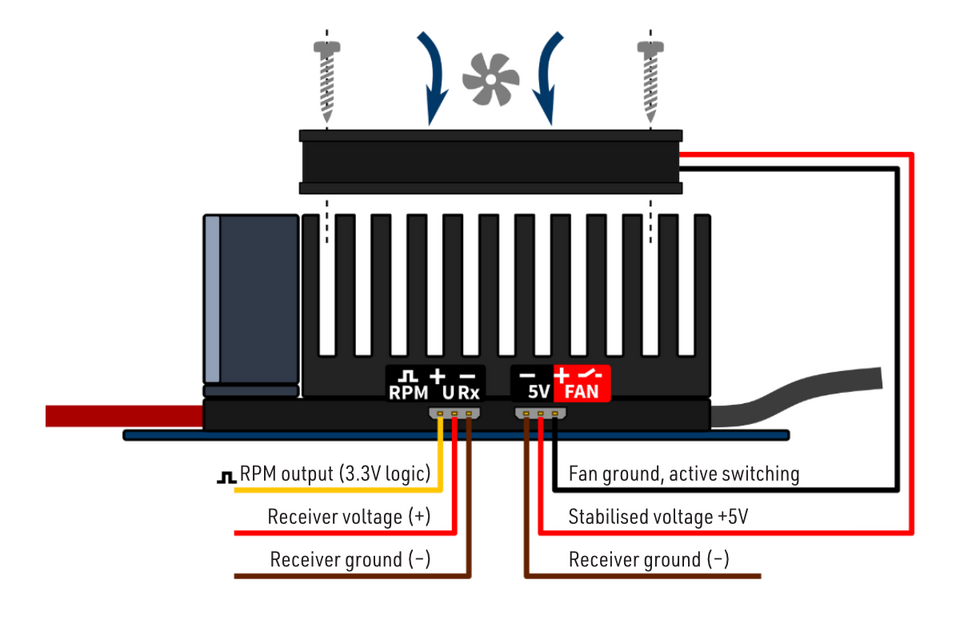
Telemetrie und Einstellung
Schließen Sie das rote Datenkabel an den Slot für Sensoren an der JETIBOX / SMART-BOX (oder am entsprechenden Empfänger) an. Versorgen Sie es mit einer 4,5-8,4 V Batterie. Sie können nun den Regler mit Hilfe der Pfeile auf dem Terminal sicher konfigurieren.
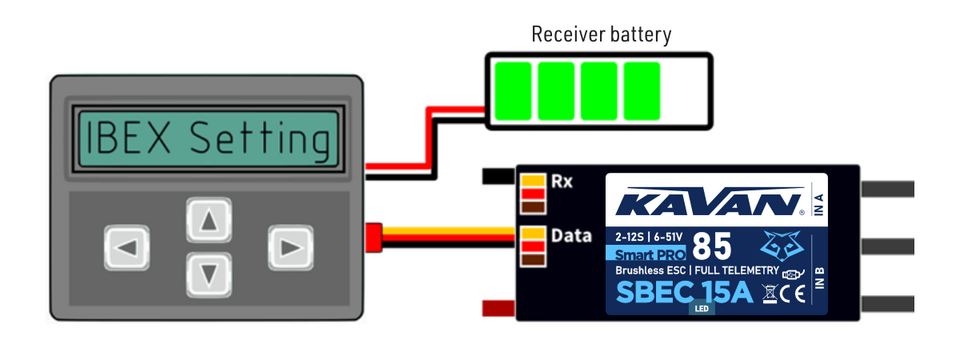
Regler KAVAN Smart PRO sind mit der JETIBOX-Einstellung kompatibel. Das JETIBOX-Menü ist in fünf Bereiche unterteilt:
Aktuelle Werte
Zeigt die aktuellen Telemetriewerte zusammen mit den Minima und Maxima an.
- Verfügbare Telemetrie: Spannung, Strom, Kapazität, Drehzahl, Leistung (in Prozent), Temperatur.
- Wenn der Chip Motor-ID angeschlossen ist, werden auch die Motoridentifikation und die Temperatur angezeigt.
- Reset Min/Max - Drücken Sie die linke und rechte Taste gleichzeitig, um alle minimalen und maximalen Werte zurückzusetzen.
Allgemeine Einstellungen
Grundeinstellungen des Reglers
- Regler-Modus - grundlegender Regler-Modus (normal oder schnell).
- Ton nach Start - wählen Sie die Melodie, die nach der Initialisierung des Reglers abgespielt werden soll.
- Standby-Piepton' - Sie können kurze, wiederholte Pieptöne als Hinweis auf einen eingeschalteten Motor aktivieren.
- Motorendpunkte, Motorstart, Motor voll - Einstellungen in Bezug auf die Dekodierung des Gaseingangssignals.
- Kapazitätsreset' - Sie können wählen, zu welchem Zeitpunkt die Kapazität und die verbrauchte Energie zurückgesetzt werden:
- Nach dem Einschalten - die Kapazität wird nach der Initialisierung des Reglers zurückgesetzt. Es wird jedoch zunächst die Kapazität des vorherigen Laufs angezeigt, bis Sie den Motor starten.
- Spannungsänderung - die Kapazität wird gelöscht, wenn eine Batterie mit einer ähnlichen (oder höheren) Spannung im Vergleich zur maximalen Batteriespannung des vorherigen Laufs angeschlossen wird. Das bedeutet, dass jedes Mal, wenn Sie eine vollständig geladene Batterie mit derselben Zusammensetzung und Zellenzahl anschließen, wird die Kapazität gelöscht.
- Manuell - Kapazität und Energie werden nie zurückgesetzt, Sie müssen sie manuell zurücksetzen.
- Sprache - Sie können die Sprache des JETIBOX-Bildschirms wählen.
= Motoreinstellungen
Einstellungen in Bezug auf die Motorparameter.
- Richtung, Beschleunigung, Timing, Startleistung, Motortyp, Übersetzungsverhältnis, Anzahl der Motorpole - siehe Kapitel Motoreinstellungen.
- Einstellungen in Bezug auf die Bremse – siehe Kapitel Bremskonfiguration.
- Luftschraubenpositionierung, PWM-Positionierung, Positionshaltung – siehe Kapitel Luftschraubenpositionierung.
- Motor aktiviert (0/1) - der Motorstart kann in Abhängigkeit vom logischen Zustand eines bestimmten Eingangs „IN B.2“ (Stecker-Ausgang von links nach rechts: 1 = Hall-Sensor-Eingang, 2 = Eingang zur Motoraktivierung, 3 = 3,3V, 4 = GND) aktiviert oder deaktiviert werden. Wenn Sie „Vst.pin Log0/1“ wählen, müssen Sie immer den Gashebel zurücknehmen, bevor Sie den Motor starten. Wenn Sie hingegen „Autostart Log0/1“ wählen, startet der Motor, sobald der Logikwert des Eingangspins dies zulässt und die Gashebelposition über dem Leerlauf ist.
- Schalten – ermöglicht es Ihnen, das synchrone Schalten (aktive Bremse) zu aktivieren oder den Regler im Standardmodus zu belassen.
Schutz
Einstellung des Regler- und Batterieschutzes.
- Batterieentladung - Verhalten, wenn die Batterie entladen ist. Entweder nimmt die Motorleistung langsam ab oder der Motor schaltet sofort ab. Die sichere Mindestspannung wird aus der Anzahl der Zellen und der Mindestspannung pro Zelle berechnet.
- Strombegrenzung - aktivieren Sie diese Funktion, um hohe Stromspitzen und eine Überlastung des Systems zu verhindern.
- Leistungsbegrenzung bei 100°C - Sie können die maximal zulässige PWM des Reglers einstellen, wenn seine Temperatur 100°C überschreitet. Das Modell muss betriebsfähig sein, aber die Temperatur darf nicht mehr ansteigen.
Service
In diesem Menü können Sie die Version des Geräts anzeigen und es auf die Werkskonfiguration zurücksetzen.
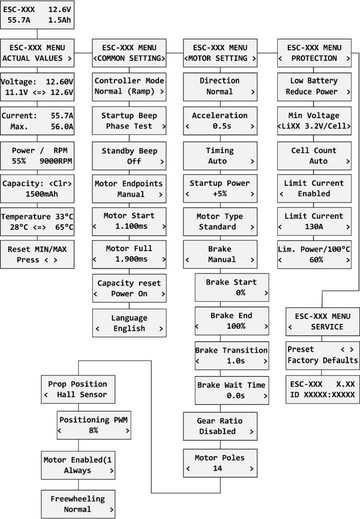
Menüstruktur der JETIBOX
Verfügbare EX und P²Bus und FPort Telemetrie:
- Akkuspannung (V)
- Motorstrom (A)
- Kapazität (mAh)
- Drehzahl (UpM)
- PWM (%)
- Leistung (W)
- Motorlaufzeit (s)
- Energie (Wmin) - nützliche Funktion für Wettbewerbe, bei denen die Gesamtenergie begrenzt ist (F5B, F5D).
- Temperatur (°C)
- Externe Temperatur (°C) - wenn ein Motor-ID-Chip angeschlossen ist, sendet der Regler die Motortemperatur als eigene Telemetrie.
- Motorstatus:
- 0 = Initialisierung
- 1 = der Motor läuft
- 2 = Bremsen
- 3 = Positionierung gestartet
- 4 = Position gefunden
- 5 = Positionsfehler (die Luftschraube hat sich bewegt)
Der Regler KAVAN Smart PRO wird standardmäßig als „Air-ESC“ Sensor erkannt.
Graupner HOTT Menüstruktur
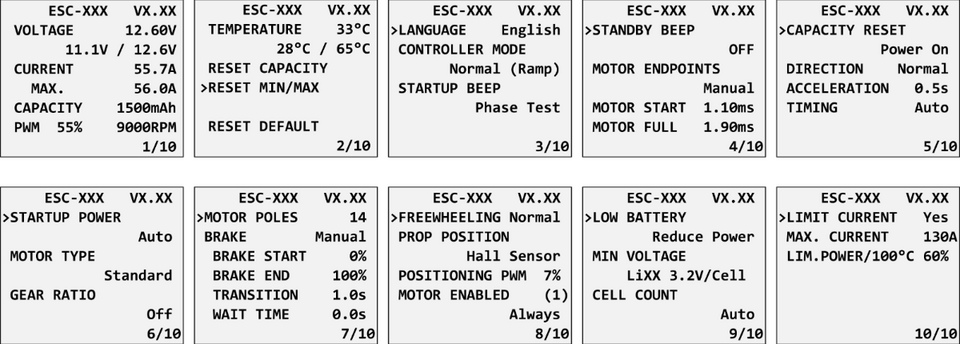
Futaba- und Multiplex-Anschluss
Futaba- und Multiplex-Systeme bieten keine drahtlose Konfiguration der angeschlossenen Geräte. Die Telemetrieübertragung ist über die folgenden festen Slots für Sensoren möglich:
| Slot Futaba S.Bus2 | Hinweis | Slot Multiplex MSB | |
|---|---|---|---|
| Drehzahl | 2 | Wählen Sie den UpM-Sensor am Slot 2. | 6 |
| Strom | 3 | Wählen Sie den Strom-Sensor SBS01C am
Slot 3. |
3 |
| Spannung | 4 | 2 | |
| Kapazität | 5 | 4 | |
| Temperatur | 6 | Wählen Sie den Sensor Temp125 am Slot 6. | 5 |
| PWM (0–100%) | 7 | Wählen Sie den Sensor Temp125 am Slot 7. | - |
| Hinweis | Manuelle Detektion im Menü Linkage - Sensor. | Automatisch vom Sender erkannt. | |
PowerBox Telemetrie
Ab Version 1.09 ist der Regler KAVAN SMART PRO in der Lage, das PowerBox P²Bus Telemetrieprotokoll zu erkennen. Schließen Sie das Telemetriekabel (roter Stecker) an den P²Bus-Port des Empfängers an. Der Sender ortet die angeschlossenen Sensoren, sobald der Empfänger eingeschaltet wird. Die Regler-Telemetrie sollte dann innerhalb von 2,5 Sekunden verfügbar sein. Sie können nun beliebigen Widgets und Alarmen auf dem Desktop des Senders Telemetriewerte zuweisen. Die verfügbare Telemetrie ist ähnlich der Duplex EX Telemetrie (siehe oben). Die Konfiguration des Reglers über den PowerBox Sender ist zur Zeit noch nicht verfügbar.
Spektrum-Integration
Ab Version 1.06 ist die Spektrum-Telemetrie-Unterstützung in eine spezielle Firmware-Version integriert. Diese alternative Firmware bietet SRXL2 Telemetrie und TextGen Einstellungen. Der Regler KAVAN Smart PRO wird im Sender durch zwei Telemetriegeräte repräsentiert:
- "ESC" zeigt Akkuspannung, Strom, BEC-Spannung, Reglertemperatur, Drehzahl und Ausgangsleistung an.
- "Flight Pack Capacity" zeigt die verbrauchte Batteriekapazität an.
Schließen Sie das Gaskabel (schwarzer Stecker) an den Thr-Empfängerport (1) an. Für einen ordnungsgemäße Telemetrie-/Setup-Funktion schließen Sie auch das Telemetriekabel (roter Stecker) an den Prog/SRXL2-Empfängerport an. Der Regler bietet standardmäßig nur numerische Telemetrie. Das Textmenü (TextGen) ist nur nach einer speziellen Startprozedur verfügbar:
- Wir gehen davon aus, dass die Gas- und Telemetriekabel richtig angeschlossen sind und der Sender eingeschaltet ist. Stellen Sie nun die Position "Vollgas" ein.
- Schalten Sie den Regler ein, entweder durch Anschluss des Antriebssets oder durch Einschalten eines externen Schalters.
- Der Motor piept und zeigt damit an, dass ein Vollgasimpuls erkannt wurde. Nach 3 Sekunden kündigt ein weiterer Piepton den Eintritt in das Programmiermenü an.
- Sie können nun den Gashebel vollständig zurückziehen. Scrollen Sie auf dem Hauptbildschirm des Senders nach rechts und suchen Sie das Menü TextGen. Wenn das Textmenü aktiviert ist, wird sich der Motor nie drehen. Wenn Sie wieder einen normalen Motorbetrieb wünschen, müssen Sie das TextGen-Menü verlassen, indem Sie auf der Hauptseite "Exit" wählen.
- Die Navigation im Menü erfolgt über die Senderhebel - der Höhenruderhebel bewegt den Cursor nach oben/unten und der Querruderhebel ändert den ausgewählten Wert.
- Die Konfigurationsänderungen werden gespeichert, sobald ein Wert geändert wird.
- Ab Version 2.01 sind die Regler KAVAN Smart PRO mit der kompletten Steuerung über ein Kabel (Spektrum Smart Throttle) kompatibel. Um diese Funktion zu aktivieren, schließen Sie einfach das rote Telemetriekabel an den Kanal Nummer 1 des Empfängers (Thro) an und lassen das andere (schwarze) Kabel ausgesteckt. Sie können dann sowohl den Gashebel des Reglers steuern als auch Telemetriedaten empfangen. Dieser Zugang ist auch mit der Empfängerfamilie AR10400T kompatibel.
- Wenn Sie einen Regler mit galvanischer Trennung (SMART PRO 200/220) verwenden, schalten Sie den Regler immer vor dem Empfänger ein. Andernfalls funktionieren die Telemetriefunktionen möglicherweise nicht.
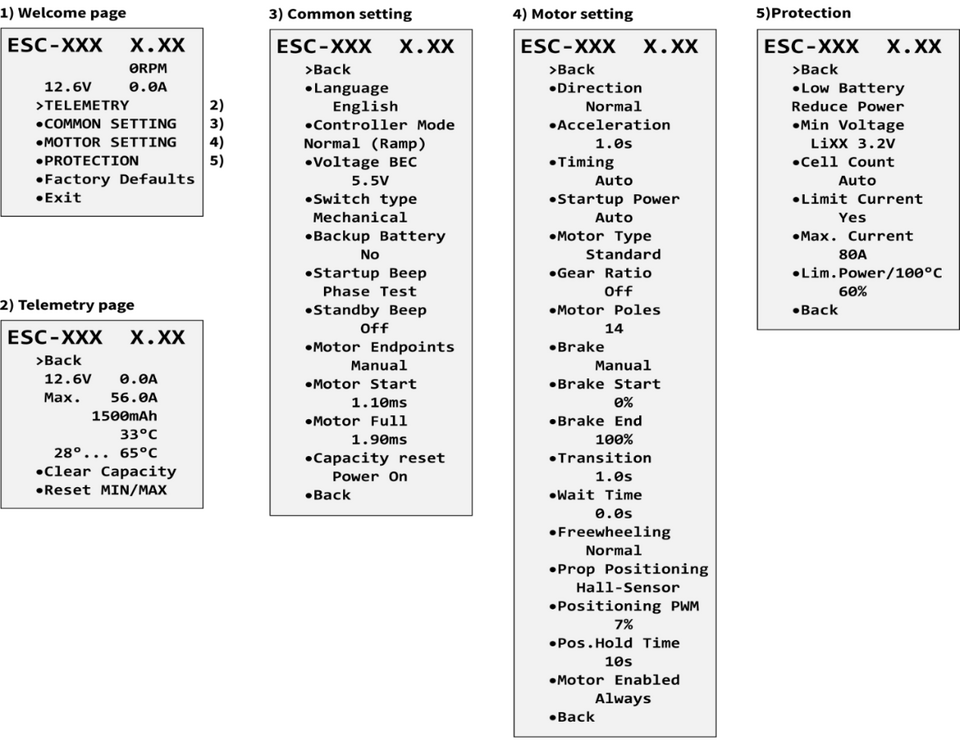
Sicherheitsinformationen
- Verwenden Sie den Regler KAVAN Smart PRO immer in einer trockenen Umgebung und innerhalb der in diesem Handbuch angegebenen Grenzwerte des Geräts. Setzen Sie das Gerät niemals übermäßiger Hitze oder Kälte außerhalb des Betriebsbereichs aus.
- Sorgen Sie für einen ausreichenden Luftstrom, um eine Überhitzung des Reglers zu vermeiden.
- Überschreiten Sie niemals die maximal zulässige Betriebsspannung des Reglers oder des Motors.
- Erhöhen Sie nicht die Kabellänge zwischen dem Regler und dem Motor. Wenn Sie die Kabel zwischen dem Regler und der Batterie auf mehr als 30 cm (insgesamt) verlängern müssen, löten Sie mehrere hochkapazitive Low-ESR-Kondensatoren (220-470 µF) parallel zu den Versorgungskabeln so nah wie möglich am Regler. Für jeden Zentimeter, der über die angegebene Kabellänge hinausgeht, muss für jedes durchfließende Ampere Stromstärke 1 µF Kapazität pro cm Länge hinzugefügt werden. Bei 10 cm über dem Grenzwert für 100 Ampere Stromstärke schließen Sie Kondensatoren mit einer Kapazität von 1000 µF an.
- Verwenden Sie stets qualitativ hochwertige Stecker in gutem Zustand. Bei sichtbaren Verschleißerscheinungen sollten Sie sie ersetzen.
- Entfernen Sie immer die Luftschraube, bevor Sie Änderungen in den Antriebseinstellungen vornehmen.
- Trennen Sie den Regler niemals von der Batterie, wenn der Motor läuft.
- Entfernen Sie die Verpackung und den Kühler nicht vom Gerät und versuchen Sie nicht, Änderungen oder Modifikationen vorzunehmen. Dies kann zur vollständigen Zerstörung und zur Verweigerung jeglicher Garantieansprüche führen.
- Überprüfen Sie immer die Polarität des Anschlusses. Verwechseln Sie niemals die Polarität - dies kann zur völligen Zerstörung führen.
Firmware-Updates
Firmware-Updates für Regler KAVAN Smart PRO werden von einem PC über USB hochgeladen. Die erforderlichen Programme und Dateien sind verfügbar unter www.mavsense.com.
Installieren Sie die MAV Manager Software und Regler für das USB-Interface in Ihren Computer. Überprüfen Sie die Systemanforderungen.
- Vergewissern Sie sich, dass die Flugbatterie abgeschaltet ist und der Regler KAVAN Smart PRO nicht mit Strom versorgt wird.
- Schließen Sie das USB-Interface an Ihren Computer an, starten Sie den MAV Manager - Updater und wählen Sie den richtigen COM-Port.
- Schließen Sie den Regler KAVAN Smart PRO wie unten gezeigt an - verwenden Sie den roten Port (Telemetrie). Der Regler wird automatisch erkannt.
- Wählen Sie die richtige Datei *.BIN aus und drücken Sie die Taste Update.

- Die Regler Smart PRO-80 und Smart PRO-120/130 benötigen keinen Anschluss an die Flugbatterie vor dem Update. Diese Regler werden direkt über das USB-Interface mit Strom versorgt.
- Der Regler Smart PRO-200/220 hingegen erfordert den Anschluss einer Antriebsbatterie von mindestens 3S LiPo, da die Stromkreise vollständig galvanisch von den Signalschnittstellen getrennt sind. Starten Sie immer zuerst den MAV Manager und schließen Sie den Regler über das USB-Interface an. Erst dann sollte eine externe Batterie angeschlossen werden, um zu verhindern, dass der Regler in den Standby-Modus geht.
PC-Konfiguration
Es ist möglich, die MAV Manager Software (Version 1.4.0 und neuer) zu verwenden, um alle Regler-Parameter bequem zu konfigurieren, Echtzeit-Telemetrie anzuzeigen oder die Konfiguration zu sichern. Das Programmmenü enthält vier Schaltflächen auf der oberen Symbolleiste:
- Neu abrufen - erzwingt das neue Abrufen der Konfiguration aus dem Regler.
- Import - importiert Einstellungen aus einer Datei. Wenn Sie mehrere Regler haben und dieselben Einstellungen für alle haben möchten, importieren Sie einfach dieselbe Einstellungsdatei in jeden Regler.
- Export - exportiert die Einstellungen aus dem Regler in eine Datei. Sie können ganz einfach eine Sicherungskopie der Konfiguration erstellen, die in Ihrem PC gespeichert wird. Nachdem Sie eine Sicherungskopie erstellt haben, können Sie ganz einfach mit den Einstellungen des Reglers experimentieren und später zur ursprünglichen Konfiguration zurückkehren, indem Sie die Schaltfläche "Import" drücken und die ursprünglich gespeicherte Datei auswählen.
- Standardeinstellungen - setzt den Regler auf die Werkseinstellungen zurück und ruft die gesamte Konfiguration neu ab.
Schließen Sie den Regler über das USB-Interface an einen Computer an. Er wird automatisch vom Programm MAV Manager erkannt.
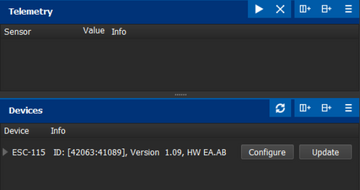
Die Eigenschaften des Reglers werden durch Drücken der Schaltfläche "Konfigurieren" aufgerufen.
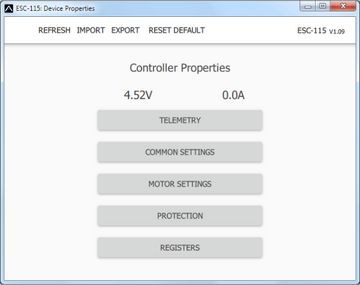
Echtzeit-Telemetrie mit Werten min/max. MAV Manager ist auch in der Lage, eine Protokolldatei aus Echtzeit-Telemetriedaten zu erstellen, die angezeigt, analysiert, importiert und exportiert werden kann.
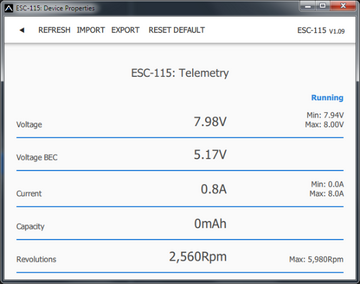
Motoreinstellungen. Bei jeder Änderung der Konfiguration wird der neue Wert sofort in den Regler übertragen und gespeichert. Eine zusätzliche Bestätigung ist nicht erforderlich. Aus Sicherheitsgründen werden einige Parameter erst nach dem Stillstand des Motors übernommen.
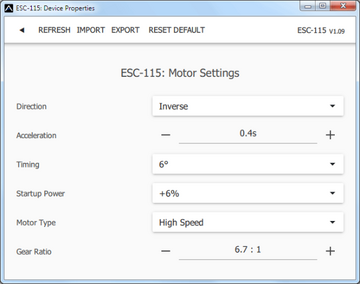
Hersteller
Alle Regler KAVAN Smart PRO werden in der Tschechischen Republik von der Firma MAV Sense s.r.o. produziert.
E-mail: info@mavsense.com | Web: www.mavsense.com
Recycling (Europäische Union)

Elektrische Geräte mit dem durchgestrichenen Mülleimersymbol dürfen nicht mit normalem Hausmüll entsorgt werden, stattdessen müssen sie an eine spezialisierte Sammel- und Recyclinganlage gebracht werden. In den Ländern der EU (Europäische Union) dürfen elektrische Geräte nicht mit dem allgemeinen Hausmüll entsorgt werden (WEEE - Waste of Electrical and Electronic Equipment – Entsorgung der Elektro- und Elektronikaltgeräte - Richtlinie 2012/19 /EU). Sie können unerwünschte Geräte zur nächsten Sammelstelle oder zum nächsten Recyclingzentrum bringen. Die Geräte werden dann kostenlos entsorgt oder sicher recycelt. Durch die Abgabe unerwünschter Geräte können Sie einen wichtigen Beitrag zum Umweltschutz leisten.
EU Konformitätserklärung (Europäische Union)

KAVAN Europe s.r.o. erklärt hiermit, dass diese KAVAN Smart PRO Regler mit den Anforderungen der relevanten europäischen Richtlinien und harmonisierten Normen übereinstimmen. Der vollständige Text der EU-Konformitätserklärung ist unter der folgenden Internetadresse verfügbar: www.kavanrc.com/doc.
Garantie
Die KAVAN Europe s.r.o. Produkte verfügen über eine Gewährleistung, die die Erfordernisse der gesetzlichen Regelungen in ihrem Land erfüllt. Falls Sie eine Beanstandung mit dem Anspruch auf Gewährleistung haben, kontaktieren Sie den Händler, bei dem Sie das Produkt gekauft haben. Die Gewährleistung deckt nicht Fehler ab, die durch Absturz, unsachgemäßer Gebrauch, unkorrekter Anschluss, Falschpolung, verspätete Wartung, Verwendung nicht originaler Zubehörteile, Veränderungen oder Reparaturen die nicht durch KAVAN Europe s.r.o. oder berechtigte Stellen, absichtliche Beschädigung, Verwendung außerhalb der zugelassenen Spezifikationen oder in Verbindung mit Produkten anderer Hersteller, entstanden sind. Bitte lesen Sie vor Gebrauch die entsprechende Bedienungsanleitung sorgfältig durch.